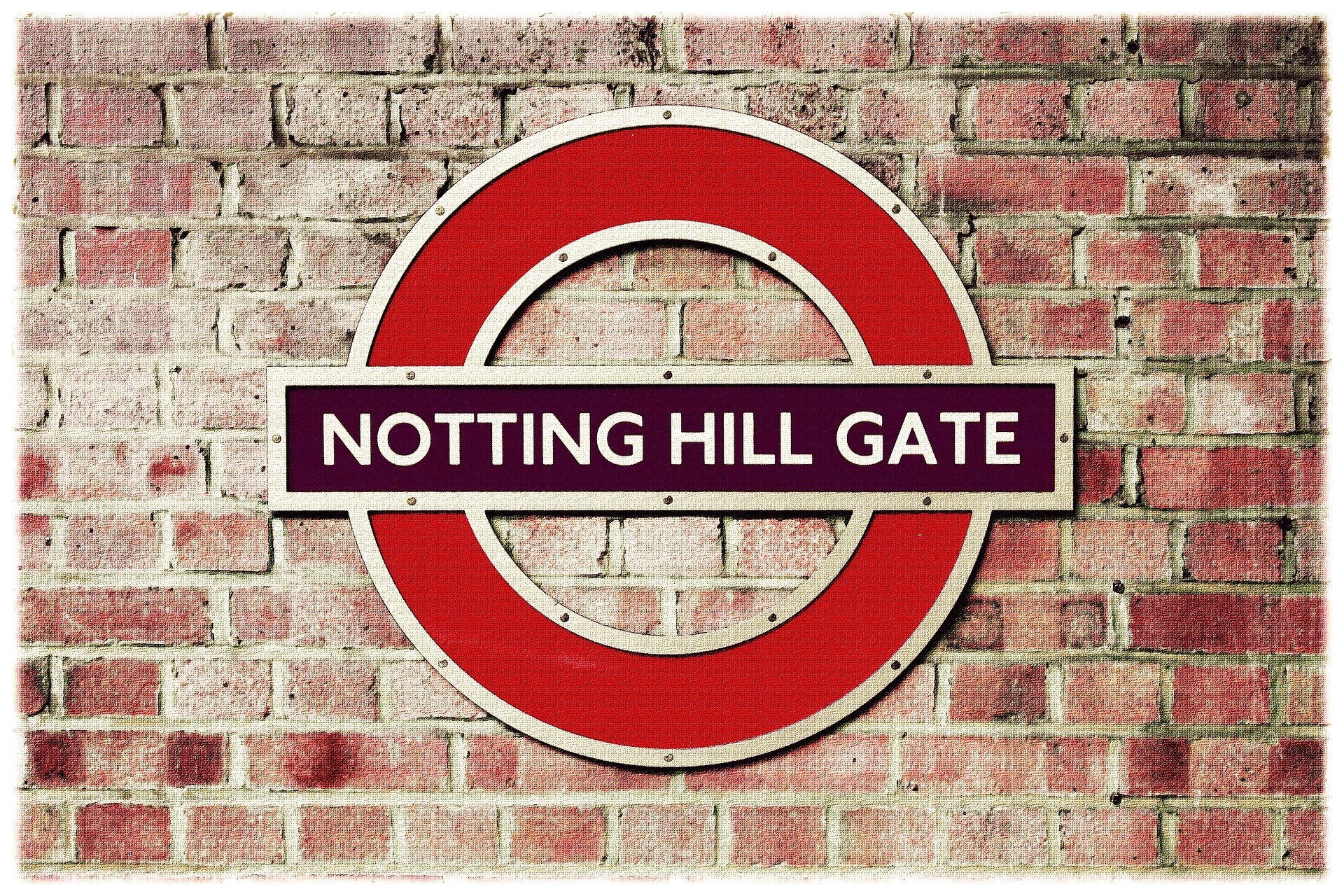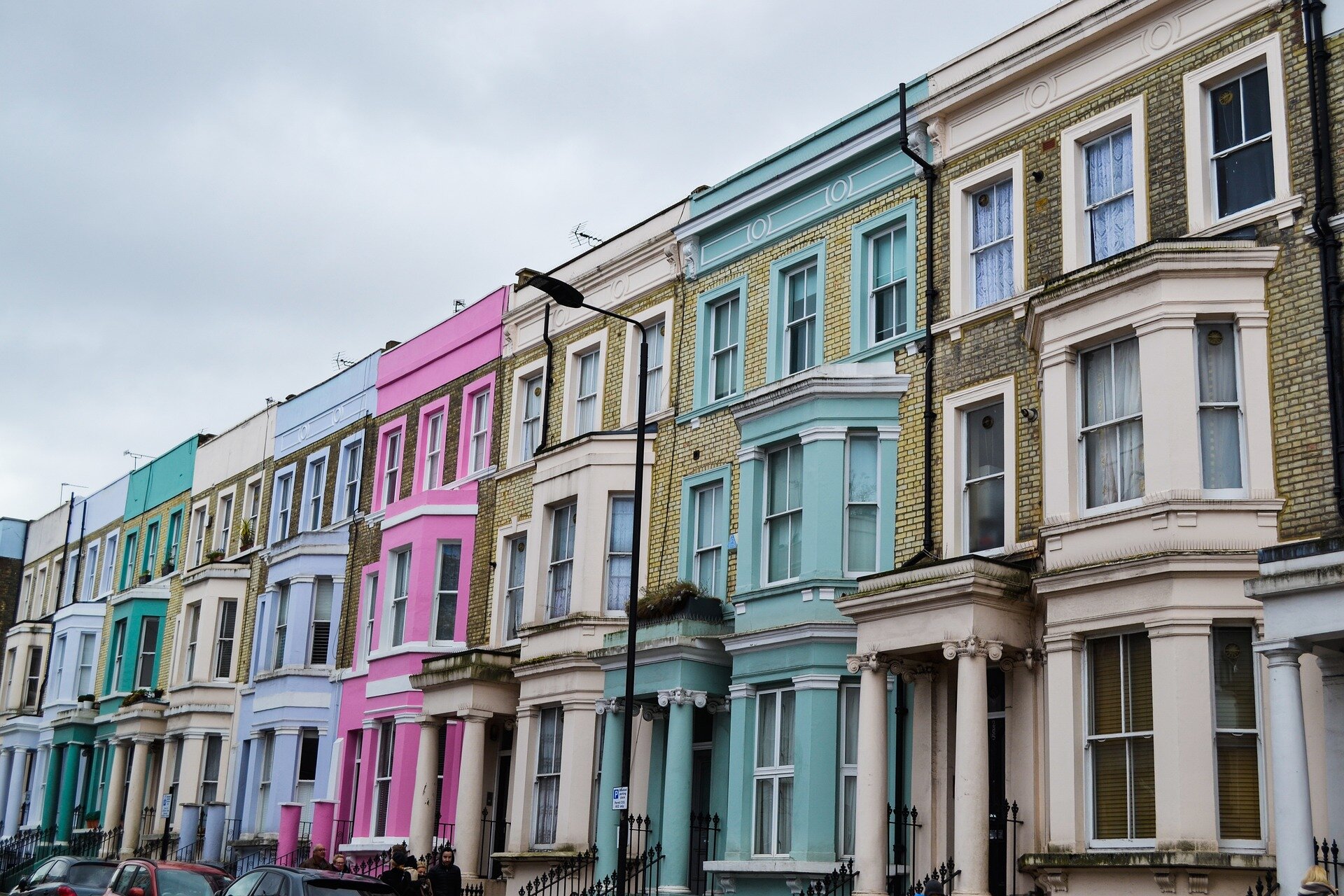Notting Hill and Portobello Rd Markets
A trendy West London area famous for its antique market
Portobello Road Market in Notting Hill will have you wandering up and down this famous road inspecting goods and wares for over a kilometre. This antique market is known for being the world’s largest and attracting tourists from all around the world. We’ll cover some race riots, a carnival, murder and a love story.
Notting Hill, A history
Notting Hill can be seen in records as far back as the 13th century. The area itself has had various versions of the name, but the most common seems to have been Knottynghull, with a ‘k’. The ‘Knott’ section (k, n, o, double t) of the name possibly being derived from the Viking King, Cnut.
If this is the case, it’s likely that a settlement at Notting Hill has existed for over 1000 years.
But it was throughout the 18th century that the Notting Hill area became known for its brick making and pig farming industries. The soil found in the clay made it perfect for making bricks and pottery. This however, left large holes in the area. A number of kilns also appeared and some of these historic kilns can still be seen on Walmer Road.
Because of the rapid expansion of the area and nearby London, a lot of the locals were forced to live in squalor. Sanitation was poor, as it often was in those days, and many of the extraction holes were filled up with a mixture of sewage, pig slurry and stagnant water. Delicious.
It was the early 19th century that saw wealthy landowner James Weller Ladbroke develop his Notting Hill estate into a carefully planned suburb. His aim was to attract wealthy Londoners to the area with large terraced houses and communal garden areas. These houses were largely used by upper middle class families who may have had a small number of servants. But the area did grow in popularity, particularly with the artistic and cultural elites of London. And this extended into residential developments in both Notting Hill and nearby Paddington, replacing pig farms and clay soil during the later years of the 19th century.
Throughout World War II, a large number of the townhouses were damaged and destroyed during The Blitz, and in response to the changing demographics of the area, there were a fair few homes that were rebuilt as Homes of Multiple Occupancy or HMOs. They usually contained a private bedroom, but then the kitchen and bathroom were communal and shared with the other occupants of the building. Many of the landlords at the time took advantage of this and the homes descended into slums.
There was one landlord that was particularly famous for his shady dealings. Peter Rachman. He was so well known for exploiting and intimidating tenants that the term ‘Rachmanism’ began to be used to describe unfortunate dealings.
It was also during this time that Notting Hill received the reputation as one of the worst areas in London. And it was just this reputation that ultimately helped to improve the conditions of rented housing across the country. It was the Notting Hill Housing Trust that was integral in shaping and supporting legislation designed to improve the standards of rented accommodation.
After the war, Notting Hill saw a cultural heritage change when an Afro-Caribbean community began to develop in the area, following the 1948 British Nationality Act, which allowed all Commonwealth citizens to settle in the UK. This meant many of Notting Hills newest residents were from the West Indies region of the Caribbean.p The newest members of the community found work in low-paid manual labour jobs, but this put them in direct competition with the white working-class residents in the area. Who found themselves already experiencing poverty and exploitation from employers and slum landlords, creating the perfect conditions for tensions to flare.
Tensions finally came to a head in 1958, when a small group of white youths attacked a white Swedish woman because she was known to be married to a black Jamaican immigrant. After the initial attack, the group’s numbers surged and started to target West Indian homes in the area. Fighting, rioting and general civil unrest spread throughout Notting Hill as black residents were forced to take to the streets to protect and defend themselves. The riots lasted roughly a week, and by the end over 140 people had been arrested.
After the rioting had settled down, local residents and activists decided to hold a Caribbean Carnival to celebrate Afro-Caribbean culture in the UK. The first carnival was held in St Pancras town hall and was even televised by the BBC as a way to improve race relations. After a couple of years, the Notting Hill Carnival became an annual event attracting thousands both from in and outside of the West Indian community. The Notting Hill Carnival is now the largest carnival in Europe, attracting over 1 million visitors each year.
It wasn’t until the late 20th century, when Notting Hill started to see some gentrification. The area started to regain some of its popularity amongst the upper middle class with many of the HMOs being converted back into large, single occupancy houses. Notting Hill has also become known for having some of the highest house prices in the country.
Before the market
The Notting Hill area is well known as the home of the Portobello Road Market. But before the market, prior to 1740, there was originally a winding country path known as Green Lane. Green Lane led from the Kensington Gravel Pits at Notting Hill Gate up north to Kensal Green.
The street took its name from the Porto Bello Farm, which used to be in the area that is now known as Golborne Road. The farm was named after the Spanish town of Puerto Bello in the Caribbean that was captured by the British in 1739. It was named in the memory of Admiral Vernon who was the one who captured the town. These roots can still be found today through pub names such as Portobello Gold and Portobello Star, as well as the antiques Arcade known as Admiral Vernon.
For much of the 18th and 19th centuries, Portobello Road remained a simple country lane connecting the south to the north, but due to erratic development on and around the road, shops and markets started springing up in reaction to the area becoming a hub for the wealthy inhabitants of nearby Paddington.
Residential development really started to take off in the Portobello Road area, with elegant terraces and crescents being built for wealthy people attracted to the district. The northern end of the road was the final part of the development. The catalyst for this was the opening of Notting Hill Station in 1864, (now known as Ladbroke Grove) and was part of the new Metropolitan Railway, which is now the Hammersmith and City line. And after WWII, the area experienced another influx of international residents.
Until the 1940s, the Portobello Rd Market was like many others in London. It mainly sold food and other essential items. Throughout the 1940s more and more of the ‘rag and bone’ men started selling their wares and they were soon joined by other traders who specialised in bric-a-brac and antiques. Over time, the market began to be known for its antiques and was well established as an antiques market by the 1950s.
Throughout most of the 20th century, Portobello Road suffered a lack of investment and by the late 1980s, there was a large amount of gentrification, and Portobello Road went from being a run-down and shabby working class district to being affluent, fashionable and one of the most desirable areas to live in the capital and this helped the popularity of the market. And even attracted Hollywood’s elite in the Richard Curtis film Notting Hill.
Notting Hill, the movie
For those who haven’t seen it, Notting Hill starred Hugh Grant and Julia Roberts and is said to have changed the image of the Notting Hill area forever, by putting the suburb on the international map, and boosting tourism and house prices.
Scriptwriter Richard Curtis decided that Notting Hill would be the perfect place to set a transatlantic love story because of the real ‘melting pot’ feel of the area.
Rather than building a studio model of the area many of the scenes were filmed on location, which meant that in order to get filming permission, hundreds of business owners had to be contacted to provide authorisation. As part of the filming request, the producers offered to donate a small sum of money to each individual’s nominated charity, meaning that over 200 British charities ended up receiving donations as a result of the filming.
The main scenes were set in prime locations throughout Notting Hill. Will’s bookstore ‘The Travel Book Shop’ was on Portobello Road itself. And the iconic blue doorway that was Will’s flat is along Westbourne Park Road. You may even be able to spot it if you wander down that way.
Notting Hill has some other screen credits. These include when The Beatles filmed part of their music video A Hard Day’s Night in the streets. Portobello Markets is also famous for Mick Jagger finding his famous red hussar’s jacket at ‘I was Lord Kitchener’s Valet’. As well as, unfortunately, being the death place of Jimi Hendrix at the Samarkand Hotel on Lansdowne Crescent.
Famous residents
Taking a little side-step, here are just a few of Notting Hill’s more famous residents.
As a mid-19th century wealthy landowner, James Weller Ladbroke began converting a large area of his estate into a luxurious suburb for London’s middle classes, this attracted artistic, cultural and political elites from London.
Poet, novelist and social commentator, Thomas Hardy, lived in the Westbourne Park area of Notting Hill when working for an architect in the 1860s. Supposedly, Hardy never felt at home when he was living in London, because of the distinct social divides that could be seen throughout the area.
Children’s author, Elizabeth Clark, had many of her stories turned into early television programmes for children. The programme, Children’s Corner, went on to run from 1924 to 1926.
George Orwell moved into rooms on Portobello Road in 1927. He was a regular amongst the poorer parts of London, in an effort to gain a better understanding of people whose upbringing differed from his own.
One of Notting Hill’s most infamous residents, John Christie, was found guilty of murdering at least 8 people at his flat on Rillington Place. His victims were stored in secret spaces within the house. Another man was wrongfully hung for the murders. And just in case you live in Notting Hill on Rillington Place and are thinking, ‘just great, with my luck, I’m probably living in the murder house.’ Fear not, dear friend, for the murder house was demolished along with the rest of the street for good measure.
Carnival creator, Claudia Jones, obviously lived in Notting Hill, and was even asked by the BBC to host the broadcast of the first celebrations. She’s also credited with creating the UK’s first West Indian newspaper.
Stella McCartney, of fashion designer fame owned a townhouse in Notting Hill and it was the Bohemian vibe of the area that helped inspire McCartney too many of her designs.
A controversial resident, as all politicians turn out to be. Former British PM, David Cameron lives in the North Kensington area. As leader of the Conservative Party in 2005, he was PM for 6 years, before the headache of Brexit started and he resigned following the European Union Referendum in 2016, which four years on they’ve only just figured out.
Notting Hill today
Today, Notting Hill is divided up into a number of different areas, each with their own unique character and points of interest.
Ladbroke Grove is one of the main roads forming the crux of the northern part of Notting Hill. Named after the wealthy landowner previously mentioned, Ladbroke Grove is one of the most diverse areas in Notting Hill. Most of the route of the Carnival pass through Ladbroke Grove and it has a strong Slavic Community.
Notting Hill Gate runs through the heart of the suburb, and the road used to be home to quite a few toll gates, where travellers would be taxed for using the road. When the area went through some major redevelopment in the 1950s, many of the historic features were destroyed. Meaning hardly any of these old toll gates survive.
Westbourne Grove, previously the slum stomping ground of the horribly vial, Peter Rachman, is now thought of as one of the most fashionable areas.
And the aforementioned Portobello Road, famous for its market that runs for over 1km.
Unfortunately, it must be mentioned that one of the worst disasters in the history of Modern Britain took place in Notting Hill. The Grenfell Tower fire. For those of you who aren’t away, the Grenfell Tower was an apartment block that caught fire shortly after midnight on 14 June 2017, with flames consuming the upper stories of the building within minutes. 72 people were to die in the worst residential fire in Britain since the end of the Second World War. The anger-rendering thing is that the fire was entirely preventable. For years, the tenants had been complaining to the property management about the number of fire hazards. Their pleas were ignored. In the immediate aftermath, companies responsible for the management of the building came under fire. But as often does in these traumatic events, the community rallied around the survivors. The Notting Hill Methodist Church and the Al-Manaar Muslim Cultural Heritage Centre both played and continue to play a vital leadership role in supporting the survivors and bereaved families. The Grenfell Foundation was also established as a charity to support survivors.
The market today
Today, Portobello Road is home to one of London’s, and even the world’s, most iconic and famous markets. Open Monday to Saturday, Saturday’s are the main business day when all the stalls are open. Friday is also pretty busy, with smaller markets running Monday to Thursday.
While the market itself is still quite famous for its antiques, the influx of the affluent young can be thanked for exploding the fashion scene, with more and more stalls popping up selling a range of cutting edge and vintage clothing.
The road is packed with stalls from Westbourne Grove all the way up to and along Golborne Road, across under the WestWay and out to Ladbroke Grove. The Portobello Road Market, is really several markets in one. Stalls offer everything from fruits and bread to posters, clothes, ceramics and music.
The market does still retain its fresh food origins and over time, five distinct sections of the market have formed. The five sections and where you can find them are: Secondhand goods, along Golborne Road to WestWay; Clothing and fashion, in the WestWay area; household essentials, from WestWay to Talbot Road; Fruit, veg and other food, from Talbot Road to Elgin Crescent; and antiques, from Elgin Crescent to Chepstow Villas.
2015 saw the 150 year anniversary of Portobello Road Markets. It was also in 2015 that Portobello Road was set for redevelopment. The Trust was tasked with overseeing the modernisation of Portobello Green Arcade and Portobello Market Canopy. Boris Johnson, London Mayor at the time, pledged £140 000 towards the project, and it definitely divided opinion. The proposal outlined a mixed-use area with vintage stalls possibly moved into modern units that mirror the inside of a Westfield. Protests and positions have at least put these major redevelopment plans on hold.
Despite possible future redevelopments, Portobello Road remains one of London’s most famous streets, and continues to be one of London’s must-see destinations. Although Notting Hill is generally classed as a prestigious and luxurious neighbourhood in Kensington and Chelsea, with its garden squares and traditional white-stucco property features. Portobello Road has retained a distinct character and boutique charm that has attracted younger buyers into the market, alongside city professionals and families.
Disclosure: As an affiliate marketer, we may receive a commission on products that you purchase through clicking on links within this website.
For those in the UK - click here
-
The True Story behind the bookstore in Notting Hill - MyLondon
Who were the Mangrove Nine? - Evening Standard
Where Madame Tussaud’s wax models were made? - MyLondon
Portobello Rd to become traffic-free - Antiques Trade Gazette
Portobello Rd out of Lego - MyLondon
The Market stall that’s been run by the same family for 150 years - MyLondon
-
Portobello Road Market - Visit London
Portobello Road and Market History
Brief History of Portobello Road Market
Iconic History and Redevelopment - Astons London
Portobello Rd Market - My Notting Hill
History of Portobello Rd Market - Sandersons London
A brief history of Notting Hill - The History Press
Five historical things to look out for in Notting Hill - TimeOut



























